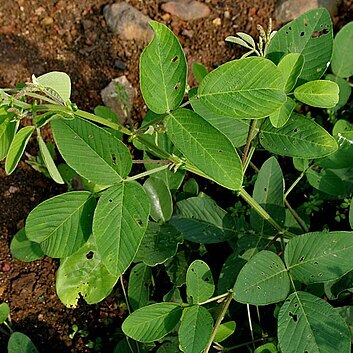Subshrubs, shrubs, or perennial herbs. Leaves 1-foliolate or imparipinnately 3-or 5-9-foliolate, stipulate and stipellate. Racemes or panicles, terminal or axillary. Flowers numerous, dense, small. Bracts deciduous or persistent, imbricate, 2-flowered at each bract; bracteoles absent. Pedicel elongated after anthesis, apically hooked, rarely not curved. Calyx 5-lobed, lower 3 lobes usually longer, upper 2 lobes partly connate. Standard orbicular or broadly obovate, clawed, auriculate; wings adherent to keel, shortly clawed, auriculate; keel obtuse, slightly incurved, auriculate. Stamens diadelphous (9+1); anthers uniform. Ovary subsessile, 2-10-ovuled; style incurved, linear; stigma capitate. Legume small, jointed; articles 2-8, plicate or peltate, folded laterally or longitudinally, not dehiscent, with 1 seed per article.
Fruit folded like a concertina, mostly enclosed in the persistent calyx, subsessile, constricted between the seeds, the segments ovate, inflated, 1-seeded and indehiscent.
Corolla yellowish or purplish; standard rounded or obovate, narrowed into a claw; wings oblong-falcate, adhering to the keel, which is slightly incurved and obtuse.
Inflorescences mostly terminal spike-like racemes or panicles; primary bracts ovate or lanceolate, persistent or deciduous; secondary bracts and bracteoles absent.
Leaves pinnately 3–9-foliolate, less often partly or all 1-foliolate; leaflets often large and venose; stipules persistent, free, acuminate; stipels present.
Calyx 5-lobed; 3 lower lobes equal, and longer than the upper pair (often appearing to be lower pair due to twisting).
Ovary sessile or shortly stipitate, 2–many-ovuled; style filiform, recurved at apex; stigma terminal, capitate.
Seeds subglobose or compressed, oblong-ellipsoid; hilum lateral, aril not developed.
Perennial herbs or subshrubs, prostrate or erect.
Vexillary stamen free; anthers uniform.

